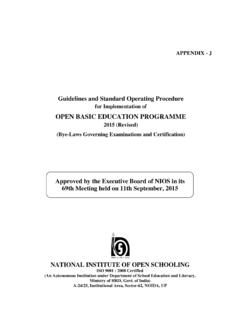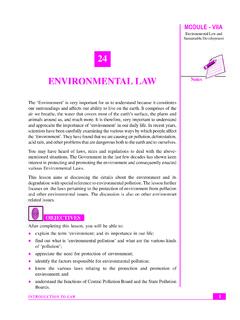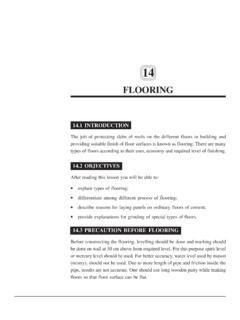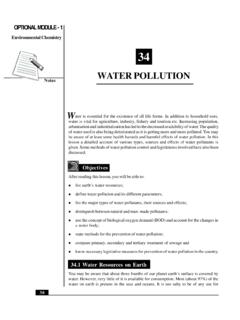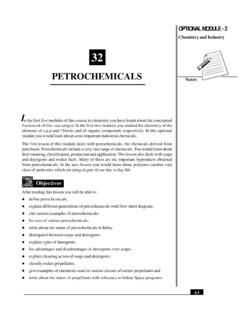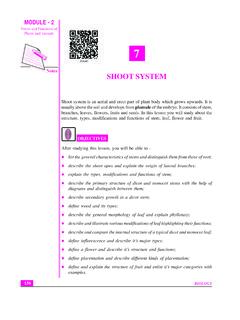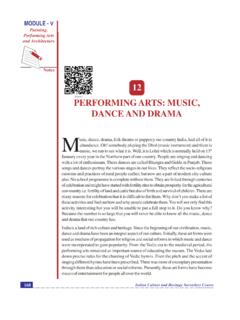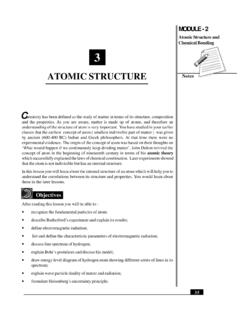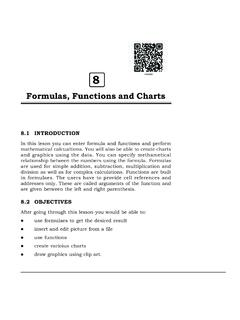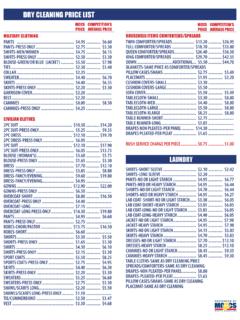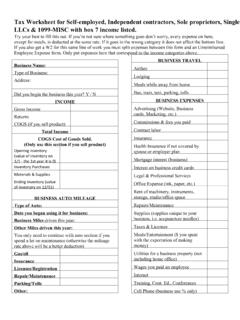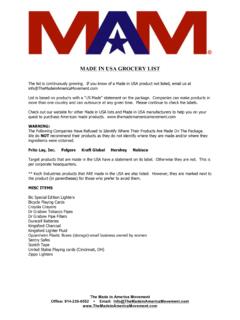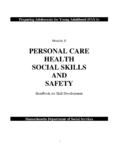Transcription of BASIC COST CONCEPTS - National Institute of Open Schooling
1 ACCOUNTANCYMODULE - 6 BNotesBasic Cost ConceptsElementary Cost Accounting 106In the previous lesson you have learnt about cost accounting. If you decideto manufacture say electronic digital meter, you will need raw material,labour and incur other incidental expenses to manufacture. These constitutethe cost of manufacturing. You will incur expenses till your products aresold. You need to learn the concept of cost, its elements and types etc. sothat you can better learn the accounting of costs. In this lesson you will learnabout the BASIC cost studying this lesson, you will be able to: state the meaning of cost; explain the elements of cost; state the meaning of overheads; explain the classification of COST : MEANING AND ITS ELEMENTSThe term cost means the amount of expenses [actual or notional] incurredon or attributable to specified thing or per Institute of cost and work accounts (ICWA) India, Cost is measurementin monetary terms of the amount of resources used for the purpose ofproduction of goods or rendering get the results we make efforts.
2 Efforts constitute cost of getting theresults. It can be expressed in terms of money; it means the amount ofexpenses incurred on or attributable to some specific thing or activity. The28 BASIC COST CONCEPTSMODULE - 6 BElementary Cost AccountingNotes 107 BASIC Cost ConceptsACCOUNTANCY term cost is used in this very form. In reference to production/manufacturingof goods and services cost refers to sum total of the value of resources usedlike raw material and labour and expenses incurred in producing ormanufacturing of given of costCost of production/manufacturing consists of various expenses incurred onproduction/manufacturing of goods or services.
3 These are the elements ofcost which can be divided into three groups : Material, Labour of costMaterialLabourExpensesMaterialTo produce or manufacture material is required. For example to manufactureshirts cloth is required and to produce flour wheat is material which becomes an integral part of finished product and whichcan be conveniently assigned to specific physical unit is termed as DirectMaterial . It is also described as raw material, process material, primematerial, production material, stores material, etc. The substance fromwhich the product is made is known as material. It may be in a raw ormanufactured state.
4 Material is classified into two categories: Direct Material Indirect Material Direct materialDirect Material is that material which can be easily identified and relatedwith specific product, job, and process. Timber is a raw material for makingfurniture, cloth for making garments, sugarcane for making sugar, and Gold/silver for making jewellery, etc are some examples of direct material. Indirect materialIndirect Material is that material which cannot be easily and convenientlyidentified and related with a particular product, job, process, and stores, oil and waste, printing and stationery etc, are someexamples of indirect material. Indirect materials are used in the factory, theoffice, or the selling and distribution - 6 BNotesBasic Cost ConceptsElementary Cost Accounting 108 LabourLabour is the main factor of production.
5 For conversion of raw material intofinished goods, human resource is needed, and such human resource istermed as labour. Labour cost is the main element of cost in a product orservice. Labour can be classified into two categories: Direct Labour, and Indirect labour Direct labourLabour which takes active and direct part in the production of acommodity. Direct labour is that labour which can be easily identifiedand related with specific product, job, process, and activity. Directlabour cost is easily traceable to specific products. Direct labour costsare specially and conveniently traceable to specific products. Directlabour varies directly with the volume of output.
6 Direct labour is alsoknown as process labour, productive labour, operating labour, directwages, manufacturing wages, etc. Cost of wages paid to carpenter formaking furniture, cost of a tailor in producing readymade garments, costof washer in dry cleaning unit are some examples of direct labour. Indirect labourIndirect labour is that labour which can not be easily identified andrelated with specific product, job, process, and activity. It includes alllabour not directly engaged in converting raw material into finishedproduct. It may or may not vary directly with the volume of employed for the purpose of carrying out tasks incidental togoods or services provided is indirect labour.
7 Indirect labour is used inthe factory, the office, or the selling and distribution department. Wagesof store-keepers, time-keepers, salary of works manager, salary ofsalesmen, etc, are all examples of indirect labour cost incurred in the production of finished goods other than materialcost and labour cost are termed as expenses. Expenses are classified intotwo categories:Direct expenses, andIndirect expenses (An item of overheads)MODULE - 6 BElementary Cost AccountingNotes 109 BASIC Cost ConceptsACCOUNTANCYD irect expensesThese are expenses which are directly, easily, and wholly allocated tospecific cost center or cost units.
8 All direct cost other than direct materialand direct labour are termed as direct expenses are also termed as chargeable expenses. Some examplesof the direct expenses are hire of special machinery, cost of special designs,moulds or patterns, feed paid to architects, surveyors and other consultants,inward carriage and freight charges on special material, Cost of patents Cost center means a location, person, or item of equipment or groupof these for which costs may be ascertained and used for the purposeof cost Cost object is anything for which a separate measurement of cost isdesired. It may be a product, service, project, or a expensesThese expenses cannot be directly, easily, and wholly allocated to specificcost center or cost units.
9 All indirect costs other than indirect material andindirect labour are termed as indirect expenses. Thus,Indirect Expenses = Indirect cost Indirect material Indirect expenses are treated as part of overheads. Rent, rates and taxes ofbuilding, repair, insurance and depreciation on fixed assets, etc, are someexamples of indirect QUESTIONS are the features of the various elements of cost. Write the nameof the element against each statements :(i) A substance from which product is made(ii) material which can be identified and related with specific product.(iii) labour which takes active and direct part in the production of thecommodity.
10 (iv) expenses that are directly and wholly allocated to specific cost centreACCOUNTANCYMODULE - 6 BNotesBasic Cost ConceptsElementary Cost Accounting OVERHEADS : MEANINGThe term overhead has a wider meaning than the term indirect include the cost of indirect material, indirect labour and indirectexpenses. This is the aggregate sum of indirect material, indirect labour andindirect = Indirect material + Indirect labour + Indirect expensesOverheads are classified into following three categories: Factory/works/ production overheads Office and administrative overheads Selling and distribution overheads Factory/works overheadsAll indirect costs incurred in the factory for production of goods is termedas factory/works overheads.
